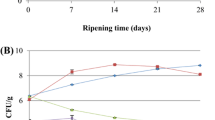Abstract
Lactobacillus paracasei was used to produce fermented spicy rabbit meat. A series of indexes were determined, including pH value, free amino acid content, true protein content, texture, microstructure and the volatile compounds of fermented spicy rabbit meat and unfermented spicy rabbit meat. The results showed that Lactobacillus paracasei could reduce the pH value of spicy rabbit meat (from 6.85 to 4.65), could degrade the proteins of spicy rabbit meat, could increase the content of free amino acids (from 205.1 mg/100 g to 505.6 mg/100 g), and could improve its textural properties and organoleptic quality of the spicy rabbit meat. The microstructure of the fermented spicy rabbit meat and unfermented spicy rabbit meat was observed by scanning electron microscope. The results showed that the microstructure of the fermented spicy rabbit meat changed obviously, the arrangement of muscle fibers was loose or even seriously broken, and many small pieces were formed, which indicated that the fermentation could improve the tenderness of the rabbit meat. The kinds of volatile flavor compounds after fermentation were increased from 14 to 40 as estimated by solid phase microextraction and GC–MS. Therefore, utilization of microbial fermentation technology can improve the quality, texture, tenderness and flavor of spicy rabbit meat, and enhance the digestion and absorption capacity.




Similar content being viewed by others
References
Ansorena D, Zapelena MJ, Astiasarán I, Bello J (1998) Addition of palatase M (lipase from Rhizomucor miehei) to dry fermented sausages: effect over lipolysis and study of the further oxidation process by GCMS. J Agr Food Chem 46(8):3244–3248
Brewer MS (2009) Irradiation effects on meat flavor: a review. Meat Sci 81(1):1–14
Benkerroum N, Daoudi A, Hamraoui T, Ghalfi H, Thiry C, Duroy M, Evrart P, Roblain D, Thonart P (2010) Lyophilized preparations of bacteriocinogenic Lactobacillus curvatus and Lactococcus lactis subsp. lactis as potential protective adjuncts to control Listeria monocytogenes in dry-fermented sausages. J Appl Microbiol 98(1):56–63
Chang SS, Peterson RJ (2010) The basis of quality in muscle foods recent developments in the flavor of meat. J Food Sci 42(2):298–305
Chen J, Jiang YS, Yan TT (2014) Effect of starter cultures on changes in free fatty acids in dried rabbit meat slice. Food Sci 35(11):174–178
Chen GS, Zhou LM (2004) Analysis of nutritional characteristics of wild crossbred pig muscle. Swine Production 1:24–27
Dong J (2011) Nutritional analysis of rabbit meat fermented sausage. J Anhui Agric Sci. https://doi.org/10.13989/j.cnki.0517-6611.2011.33.032
Davies A (1998) The microbiology of meat and poultry. Blackie Academic and Professional, London, pp 288–320
Flores M, Grimm CC, Toldrá F, Spanier AM (1997) Correlations of sensory and volatile compounds of Spanish “Serrano” dry-cured ham as a function of two processing times. J Agr Food Chem 45(45):2178–2186
Fan WL, Xu Y (2014) Flavor chemistry of alcoholic beverage. China Light Industry Press, Beijing
He YB (2002) Study on the changes of Lactobacillus during fermentation. Meat Industry 2002(5):23–28
Li CT, Lv JL (2005) Development trend of Lactobacillus and its fermented dairy products. China Brewing 24(8):5–7
Li L (2012) Study on the processing technology optimization and volatile flavor in the dried tangerine rabbit. Southwest University, Chong Qing
Ling DW (1999) Classification, identification and experimental methods of lactic acid bacteria. Microbiol Bull. https://doi.org/10.13344/j.microbiol.china.1999.01.007
Ma CW (1995) Research progress of meat flavor abroad (Review). Meat Res 2:13–17
Na W, Sheng YP, Xu JQ, Fan Y, Jing W, Zhao LH (2017) Effect of different heating on the quality of fermented beef. Food Ind. CNKI:SUN:SPGY.0.2017-06-033
Porto-Fett ACS, Call JE, Shoyer BE, Hill DE, Claudette P, Cocoma GJ, Luchansky JB (2010) Evaluation of fermentation, drying, and/or high pressure processing on viability of Listeria monocytogenes, Escherichia coli O157:H7, Salmonella spp., and Trichinella spiralis in raw pork and Genoa salami. Int J Food Microbiol 140(1):61–75
Su L (2019) Purification, inhibitory characterization, and mechanism preliminary study of Lactocins produced by Lactobacillus paracasei. Sichuan University of Science and Engineering, Yi Bin
Wu GF, Li GQ, Ma YQ (2006) Industrial fermentation analysis. Chemical Industry Press, Beijing
Wasseriwan AE (2010) Symposium on meat flavor. Chemical basis of meat flavor: a review. J Food Sci 44(1):6–11
Wang J, He ZF, Li HJ, Liu YN (2013) Determination of flavour compounds in rabbit meat by HS-SPME/GC-MS. Food Sci 34(14):212–217
Zotte AD, Szendrő Z (2011) The role of rabbit meat as functional food. Meat Sci 88(3):319–331
Zhang YL, Zhang XW, Qian-Qian XU, Wang WH (2018) Study on properties of fermented rabbit meat. Food Res Dev. CNKI:SUN:SPYK.0.2018-09-020
Zhou GS (1996) Quantitative detection of true protein in feed. China Feed 7. CNKI:SUN:SLGZ.0.1996-07-018
Acknowledgements
This research was supported by Key Laboratory of Culinary Science in Sichuan Province (Item No. PRKX2017Z07), and the Key Laboratory of Green Catalysis in Sichuan Province (Item No. LYJ1701), and innovation and entrepreneurship training program for College Students (Item No. S202010622020).
Author information
Authors and Affiliations
Corresponding author
Ethics declarations
Conflict of interest
The authors declare that they have no conflict of interest.
Additional information
Publisher's Note
Springer Nature remains neutral with regard to jurisdictional claims in published maps and institutional affiliations.
Rights and permissions
About this article
Cite this article
Zhao, X., Li, S., Liu, Y. et al. Production of fermented spicy rabbit meat using Lactobacillus paracasei. Bioprocess Biosyst Eng 45, 87–95 (2022). https://doi.org/10.1007/s00449-021-02642-3
Received:
Accepted:
Published:
Issue Date:
DOI: https://doi.org/10.1007/s00449-021-02642-3




